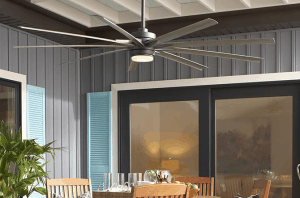Feature image Source: https://www.delmarfans.com/media/categorynav/ceiling-fans/outdoor/damp-rated.jpg
If you are unable to get an AC or cooler, for now, installing an outdoor ceiling fan can be a great option too. Besides cooling, modern waterproof outdoor fans will provide a charming vibe to your patio. Outdoor fans come with damp or wet ratings which express the capacity of the fan to sustain in damp conditions or during rain and humid weather.
Installing a ceiling fan at your patio can be the apt option as it will help to cool down the area at the day time and on the other part, it will also be circulating the cool evening breeze. The movement of air caused by the waterproof outdoor fans is quite remarkable as even if you step out for a moment, the change of temperature or the excessive heat won’t really affect you much. And thus you can always count on your outdoor fan as a real savior.
Here are some of the factors to consider when you are thinking to get an outdoor fan for your patio:
Types of outdoor ceiling fans
Outdoor fans are a lot different from the indoor ones. As they have to fight with different weather conditions, unlike the indoor ones. And thus outdoor fans are made adaptable to damp and humid weather types. Moreover, the indoor fans are termed as dry-rated while the outdoor ones can be differentiated into two types, namely, wet-rated and damp-rated.
The outdoor fans are built in such a way so that it can withstand both humidity and rain and that is why the powder-coated paint finishes are given to the fans which prevents both rust and corrosion. The motor casing comes with a waterproof seal that protects it from excessive rain and moisture.
Wet rated fans are chosen for veranda, decks and pergolas as they are designed to withstand moisture and any weather conditions. Whereas the damp rated outdoor fans are perfect ones for patios or decks or even garages.

Size
Consider the size of your patio first and then the weather conditions of your area. That will make you understand the apt size which you should get.
The following will help you to choose the diameter of the ceiling fan easily:
- For areas up to 225-400 square feet= 50-54 inches
- For areas up to 144-225 square feet= 44 inches
- For areas up to 76-144 square feet= 36-42 inches
- For areas up to 75 square feet= 29-36 inches
Color and Material
You need to take into account the color of your patio, the color of the ceiling and the color of the walls respectively. In order to make the fan look perfect with the ceiling, choose a color that would blend or contrast well with the other colors.
The fans can be made of iron, wood, galvanized steel, stainless steel or aluminum among which aluminum and stainless steel are the best ones. But most waterproof outdoor fans use ABS type plastic blades over wooden ones. ABS plastic is a highly durable plastic-type which is capable of withstanding both, water contact and extreme heat and humid conditions.

Style
Outdoor fans come in varieties of looks starting from traditional ones to contemporary or cottage styled. However, irrespective of its style, it must blend with the scheme of your patio.
Is an outdoor waterproof fan safe to use?
Definitely! Outdoor fans are built with galvanized steel and the powder-coated paint finish protects it from corrosion and rusts. Upon that the motor casing of an outdoor fan comes with a waterproof seal which protects it from moisture and rainfall. Lastly, the outdoor fan blades are made with ABS plastic as mentioned earlier and it can withstand heavy weather conditions with ease.
Outdoor fans are designed to face all weather conditions and moisture as it is being used at the outside of the house. But one can always install an outdoor fan indoors because of the added features, however, an indoor fan should never be used as an outdoor fan as it is not capable of surviving in harsh or varied weather changes.

